
|
 |  Εκτύπωση Εκτύπωση
 |  | Amathous |
, which included an atrium with a cistern at its centre. At the northeast corner of the enceinte, the two archaic stone vessels were found.
The Agora and the baths
The agora is located in the lower town at the east of the hill of the acropolis. The area south of the agora is occupied by a public bath (balaneion), which is comprised of a closed circular area and annexes. The bath along with part of the west portico of the agora date to the Hellenistic period and constitute the earliest indications of human activity in the area.
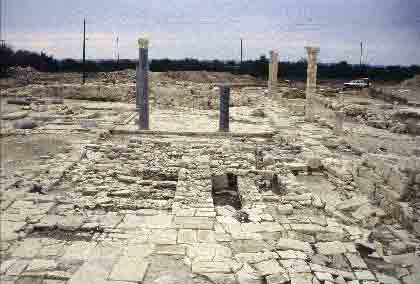
Amathous: Agora
During the Roman period the agora was organised around a large stone-paved court. An important road, which connected the agora to the lower town, runs along the south side of the agora. Three porticos occupy the other three sides. The west portico opened to the court through thirteen Doric columns and ended at its north edge at a fountain or a Nympheum and at a later cistern. Behind the north portico, which is very damaged, buildings were erected which seem to have constituted the most important administrative or religious buildings of the site. Behind the east portico is the complex of rooms belonging to a Roman bath. In the centre of the north part of the court is a rare fountain sheltered by a roof, probably in the shape of a pyramid.
The Palace
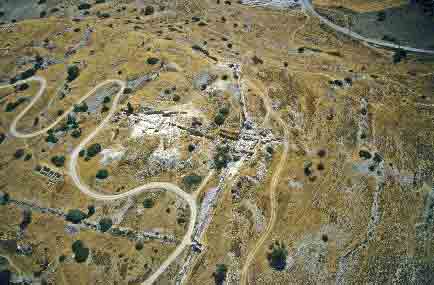
Amathous
Behind the Byzantine wall part of the palace of Amathous is preserved. It was built in the 8th century B.C. and was destroyed after the reign of the last king of the town, Androkles, around 300 B.C. The preserved ruins, where many remarkable objects such as pithoi and athoric stele have been unearthed during excavations, are part of the palace's storerooms.
The Port
The external port of the city was situated in front of the agora and its ruins are preserved today under the sea. The port was built at the end of the 4th century B.C. by Demetrios Poliorcetes, as part of the defence of the town during the period of the quarrel with the Ptolemies for the domination of Cyprus. The port's lifespan was short since it was covered by sand. In front of the agora an internal basin of the port existed where the sailors had the opportunity to pull the ships out of the water in order to better protect them from the wind.
 Amathous: The ancient port
Amathous: The ancient port
The Walls
Since the Archaic period the city was walled on all sides. The walls were reinforced during the Hellenistic period when the port was constructed. Today we can see the southwest part of the walls with the west tower near the sea, and a large part of the north wall with three towers, which linked the steps of the acropolis with the higher point of the lower city. A gate exists in the north wall, permitting the entrance to those who entered the town from the hinterland. After the destruction of the wall in the 4th century A.D., a second wall was built in the 6th century (probably by Justinian in order to face a potential military threat from Persia) in the middle of the hill of the acropolis, in front of the abandoned palace.
The Necropolis
East and west of Amathous extend two important necropolis with carved tombs which date from the Geometric to the Roman period. During the excavations of the tombs rich archaeological material came to light, part of which is now exhibited in the Lemesos District Museum.
The Basilicas
Apart from the basilica at the top of the acropolis, four other basilicas has been excavated by the Department of Antiquities. The oldest is the cemeterial basilica of Agios Tychonas, located outside the east side of the Archaic walls, and built by Saint Tychonas, first bishop of the city, at the end of the 4th century A.D. In the 5th century a three-aisled basilica was built at the footsteps of the hill of the acropolis, west of the agora, and a large three aisled basilica was built east of the agora (now partly destroyed by the sea). In the same period, on the east edge of the East necropolis, a cave-chapel dedicated to the healer-Saint Barbara was erected as well as a small five-aisled basilica, which probably formed part of a monastery.
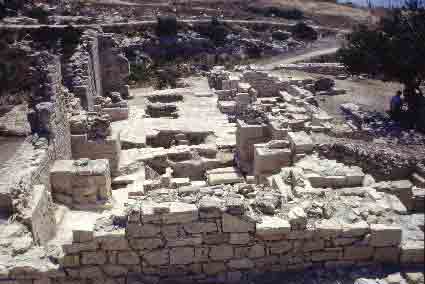
| District | Lemesos (Limassol) |
Opening hours
for Public Holiday opening hours see home page | Winter hours (16/9 - 15/4 )
Monday - Sunday: 8.30 - 17.00
Summer hours (16/4 - 15/9)
Monday - Sunday: 8.30 - 19.30
(last ticket issued at 19.00) |
| Tickets | €2,50 |
| Telephone | 25635226 |
| Accessibility | 
| District | Lemesos (Limassol) |
Opening hours
for Public Holiday opening hours see home page | Winter hours (16/9 - 15/4 )
Monday - Sunday: 8.30 - 17.00
Summer hours (16/4 - 15/9)
Monday - Sunday: 8.30 - 19.30
(last ticket issued at 19.00) |
| Tickets | €2,50 |
| Telephone | 25635226 |
| Accessibility | 
Special rest rooms: available (marked)
Partly wheelchair accessible: only the lower town can be viewed. |
INTERNATIONAL MOUNTAIN BIKE RACE AT THE ARCHAEOLOGICAL SITE OF AMATHOUS, 21st FEBRUARY 2024
The Department of Antiquities, Deputy Ministry of Culture, announces that on Wednesday the 21st February 2024 at 10:00 a.m. an international mountain bike race (Cyprus Sunshine Cup) will take place at the Archaeological Site of Amathous. During the previous days the site will be used for official training by the athletes.
The route that the cyclists will follow has been marked and there will be supervisors on site on behalf of the organizers. The Archaeological Site will be open to the public and on the 21st of February entrance will be free. Visitors to the Site are kindly requested to follow the instructions of the supervisors of the race as well as that of the antiquities guards and to be particularly cautious when moving around the Site. |
The ancient town of Amathous is situated on the south coast of Cyprus, about 7 km east of the town of Lemesos. Traces of the earliest human presence, dating to the Neolithic period, have been detected during archaeological excavations on the hills neighboring Amathous. During the Archaic period the town acquired special wealth as one of the Kingdoms of Cyprus, and had remarkable commercial relations both with the Aegean and the Syropalestinian coast. Amathous has not preserved a foundation legend. On the top of the hill of the acropolis, the Cypriot Goddess, named Aphrodite at least from the 4th c B.C., was worshipped. During the Persian occupation of the island, Amathous maintained a pro-Persian stance, a fact led to its siege by Onesilos of Salamis. The abolition of the Kingdom of Amathous, as well as of the other Kingdoms of Cyprus, at the end of the 4th c B.C (Hellenistic period), was due to the annexation of the island by the Ptolemies. Amathous enjoyed prosperity during the Antonine and Severan periods. Although the town survived the Arab raids of the mid 7th century A.D., it seems that it was definitely abandoned towards the end of the same century. The Department of Antiquities also focuses on the management, preservation and promotion of the archaeological site of Amathous, through the application of concrete strategies aiming at securing its sustainability and development.
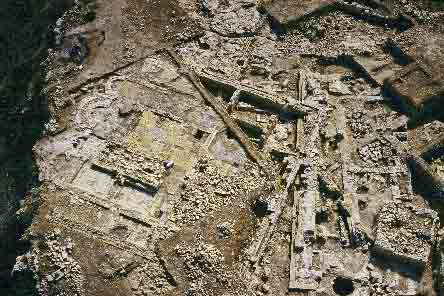 Amathous archaeological site
Amathous archaeological site
The first important excavations at Amathous began in 1893-1894 under the direction of British archaeologists A.H. Smith and J.L. Myres, who excavated many tombs. After the independence of Cyprus, in 1969 many rescue excavations, accidental discoveries and systematic excavations continued by the Department of Antiquities. From 1975 the French School of Athens undertook systematic excavations on the acropolis and other places of the ancient town.
The most important sites and monuments at Amathous are:
Acropolis
A tomb at the north edge of the hill, known as the tomb of Ariadne, constitutes the most ancient indication of human presence on the site. Although it probably dates to the 11th century B.C., it was reused during the Archaic and Classical periods, at the time of the development of the shrine. At the same time the two big monolithic vessels were used which dominated the site on the east edge of the hill. One of them is partially preserved today in situ while the other one was transported in the 19th century to Paris where it is exhibited today in the Louvre. During this period, Cypriot Aphrodite took the characteristics of the Egyptian goddess Hathor, as is witnessed by her numerous representations on vessels and by the “Hathoric stele” that was found on the acropolis. A small natural cave, which contained a large quantity of pottery, a complex related to the ritual of sacrifices with many curved holes, a pit and a structure made of pierced stones, complete our knowledge about the earliest phases of worship on the acropolis.
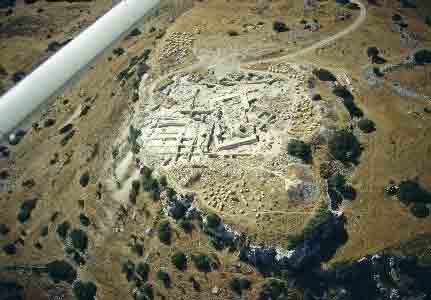
Amathous: Acropolis
The ruins of the Roman Temple of Aphrodite occupy a large part of the acropolis. It was built over the ruins of a Hellenistic temple for which we do not have much information. The Roman temple was one of the greatest centers of worship in Cyprus during antiquity and one of the most important places of pilgrimage. It was built at the end of the 1st century A.D. following the Greek type of a prostylos temple with “nabatean” capitals. It seems that in the 5th century A.D. the area surrounding the south part of the temple was used as a place of worship by the first Christians. In the 7th century the temple was already destroyed and in its place a large three-aisled basilica was erected, with a narthex, an exonarthex and many annexes. The whole complex was surrounded by a enceinte
Special rest rooms: available (marked)
Partly wheelchair accessible: only the lower town can be viewed. |
|  |
|
|